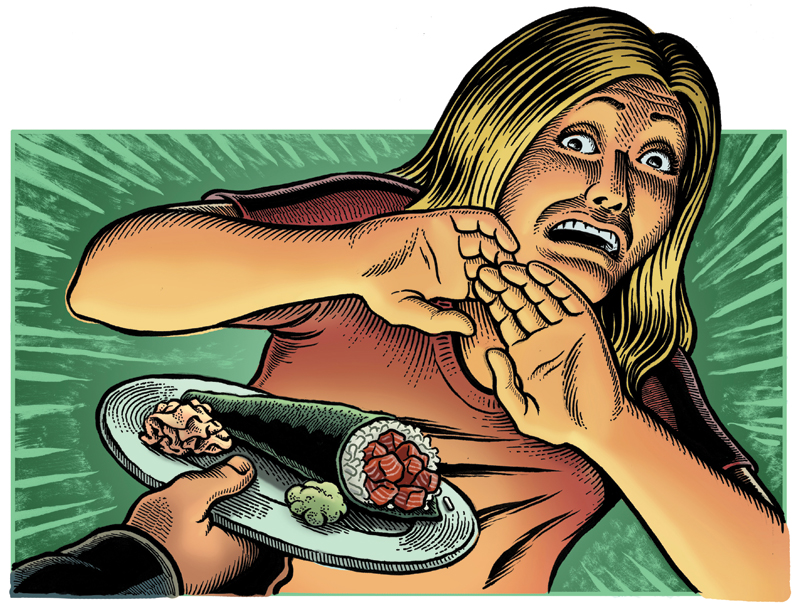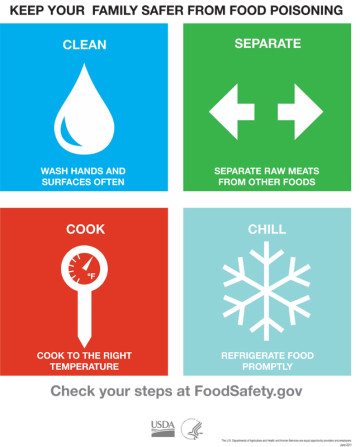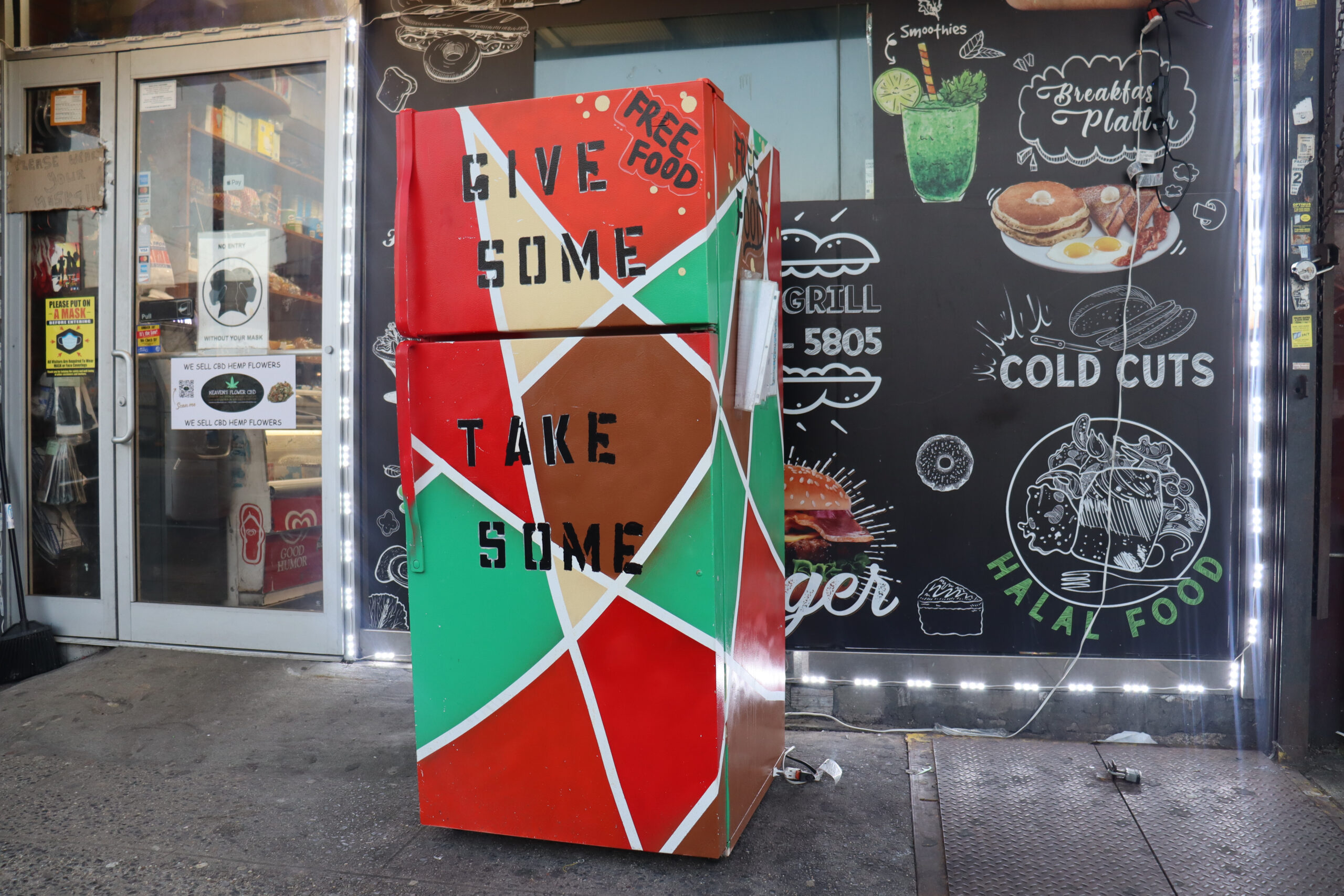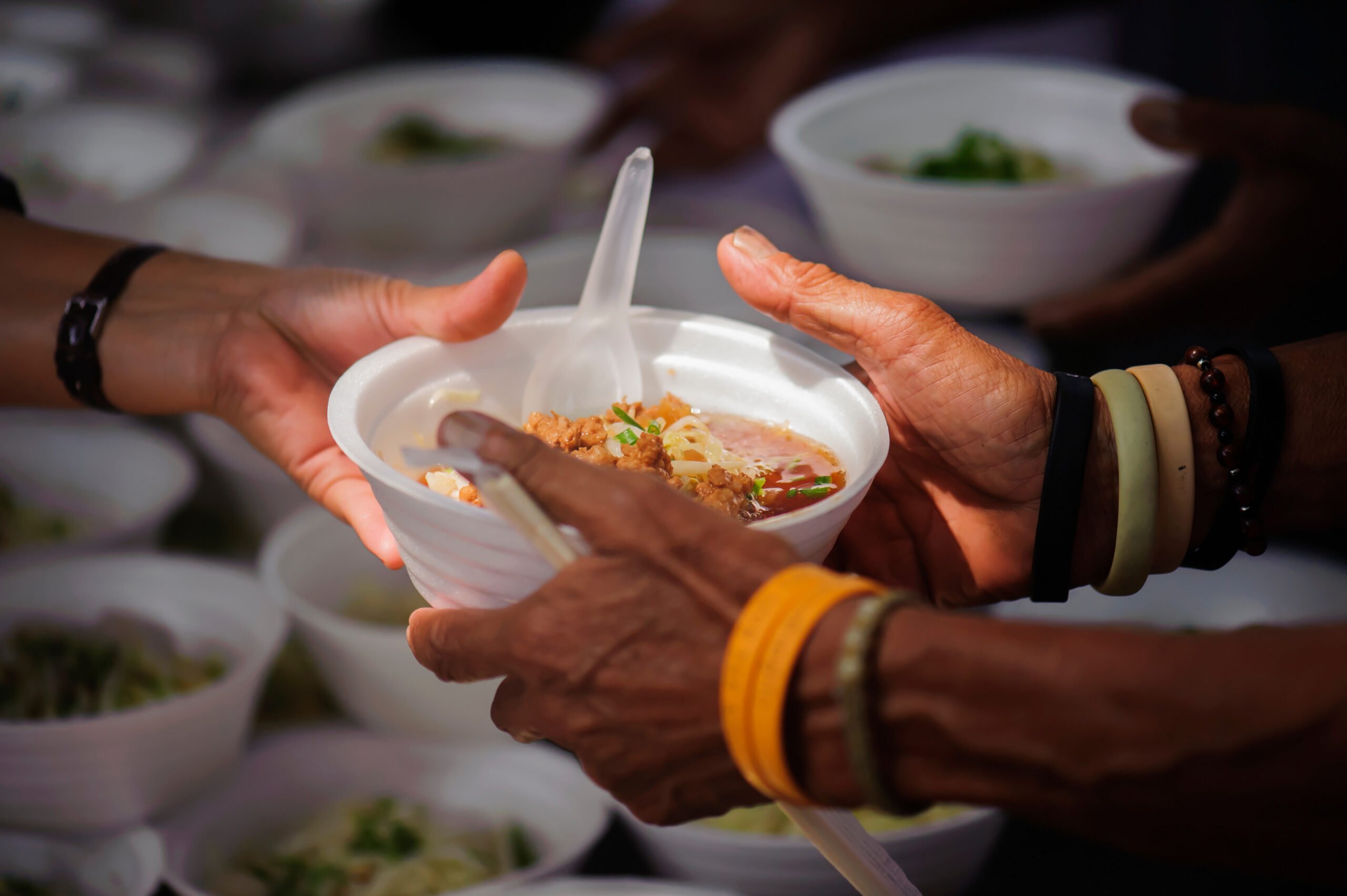
The Raw and the Overcooked: Fighting Foodborne Illness
A new public health campaign urges you to fight foodborne illness by following the steps: clean, separate, cook and chill.

A version of this story ran in the February 2014 issue.
I must have been 25 or 26 years old before I had a steak that wasn’t black on the outside and slate-gray on the inside. Acceptable meat preparation: burnt to a near crisp. Favorite meat preparation: burnt to an absolute crisp.
It wasn’t about taste. It was about survival. I knew that were a piece of even the lightest-pink meat to cross my palate, I would find myself in mortal danger.
I can trace this fear to a night at home as an elementary school kid watching my mom prepare a pan of spaghetti sauce for dinner. I was hungry—“staaaarrrrrrvingggguuhhh”—in the way that school kids can be when they’re mainly bored and looking to irritate the piss out of someone. I hovered over the stove as my mom browned a package of ground beef before adding a jar of Classico, the finest pasta sauce available at the Mansfield, Texas, Winn-Dixie.
Innocently, unthinkingly, I plucked a nob of brownish-pink beef out of the pan and popped it into my mouth.
Oh, those halcyon days that preceded decades of fear.
My mother snapped into action, wild-eyed and panicked. “ANDIE!” she cried, “did you just eat that? Don’t ever, ever do that! You’ll make yourself sick!” I swallowed hard, the ground round already halfway down my throat, and felt the agent of certain death slide into my stomach.
In retrospect, I have no doubt that Becky Grimes was, in that moment, as phlegmatic and matter-of-fact as ever. But being told no was a rarity for me, a straight-A Sunday-school superstar. I had no processing mechanism for “stop doing that.” Most of the time I never started doing “that.” Imagined consequences were always enough to keep me in line.
So when my mom said “sick,” I heard “dead.”
That half-browned ground beef never caused me a moment of physical discomfort, but as I grew up, moved out, and started preparing food for myself, I indulged a dogged dedication to overcooking any and every protein that made its way into my diet. In the kitchen, I washed my hands with religious fervor, kept multiple cutting boards, and threw out almost anything—besides ranch dressing, mustard and six-packs of High Life tallboys—that spent more than a couple of nights behind refrigerator doors.
Until one horrifying afternoon when I grabbed sushi with some new friends after moving to Austin to start graduate school. Intent on impressing the new crowd with my worldliness, and figuring I could handle raw fish if it was slathered in spicy mayonnaise, I ordered a “hand roll,” which I hoped would be a mostly-rice roll, submerged in sauce, toward which the sushi chef had whispered the word “tuna.” What I got instead was temaki: a giant seaweed-wrapped cone of glistening red fish. Mayo on the side.
I don’t know if you’ve ever had to pretend to be extremely cool in the face of imminent death, but it takes a lot out of a person. Yet I persevered. My desire not to be seen as a phobic bumpkin overcame my fear of dying 8 to 24 hours later on the cold bathroom floor of my West Campus one-bedroom. And halfway through the roll, I found myself… liking it. A lot.
That temaki opened the floodgates, introducing me to a world of food that tastes like food instead of like dry char. Nothing was off-limits: Bring me your carpaccio, good sirs! I’ll have the sashimi! How does the chef recommend I take my filet? Still on the hoof? Let it be so!
I remained careful in my own kitchen, but experimented with medium-rare salmon steaks and meatballs. I bought a flipping food thermometer, and I used it.
 And a few months ago, as I entered my fourth decade on planet Earth, I started seeing food-safety billboards, actual side-of-the-road billboards, telling me to do what I’d already been doing, if initially only out of abject fear, for so very long: “Check your steps!” these billboards advise. “Clean. Separate. Cook. Chill.” Hey, I do clean, separate, cook and chill! It was like being back in Sunday school all over again: Good girl, Andrea!
And a few months ago, as I entered my fourth decade on planet Earth, I started seeing food-safety billboards, actual side-of-the-road billboards, telling me to do what I’d already been doing, if initially only out of abject fear, for so very long: “Check your steps!” these billboards advise. “Clean. Separate. Cook. Chill.” Hey, I do clean, separate, cook and chill! It was like being back in Sunday school all over again: Good girl, Andrea!
The billboard campaign is part of a multi-organization, multi-bureaucracy effort called “Partnership For Food Safety Education,” and its “Food Safe Families” package features bright colors and simple icons, delivering easy-to-digest messages with a cheerful, retro enthusiasm: “Refrigerate food promptly,” everyone! “Separate raw meats from other foods,” dear friends!
These billboards tell me that I’m doing everything right. It’s gloriously validating. No, I’m not going to win the lottery, and no, I’m not going in for a free plastic surgery consultation, and no thank you, I really don’t want to be given a “latte choice” at McDonald’s, but I sure as hell separate my uncooked meats and raw produce. I do it like it’s my damned job.
I kind of love that there’s no gimmick, no snark, in the campaign. This is good old-fashioned Ad Council earnestness, and for many of us, the message may seem overly simplistic, obvious to the point of self-parody. But think of this: If you already know to “check your steps,” and if separating your meats and veg is second nature, consider this campaign an opportunity to reflect on what a privilege it is to have, or to need, that knowledge in the first place, in light of the fact that approximately 15 percent of your fellow Texans live in food deserts.
That’s a U.S. Department of Agriculture estimate based on the percentage of urban-dwelling Texans who live more than a mile from a grocery store, or, in rural Texas, more than 10 miles. Encouraging people to prepare food safely in their home presumes that there’s food at home in the first place. If most of the vegetables many people can afford, or even find, tend to come in a bag labeled “Lay’s,” then “clean, separate, cook, chill” stops being obvious and starts being, well, precisely what the Ad Council folks told me it’s supposed to be: an educational tool meant to help prevent food-related illnesses and contamination.
“One in six Americans each year suffers from foodborne illness,” the Ad Council’s Ellyn Fisher told me. “It’s a serious public-health issue.”
But don’t panic: These ads aren’t a response to any particular bacterial emergency or outbreak; they appear whenever media outlets—in this particular case, the Clear Channels, the Lamars and other owners of outdoor advertising platforms—feel like donating the space.
Food Safe Families is just another one of those good-citizenship-style public-service campaigns that, on the surface, can seem patronizing and even silly, but it’s precisely the kind of information that Austin’s Kate Payne, author of The Hip Girl’s Guide to Homemaking, says she’s careful to include in her work. As more and more people get interested in local food, organic food and pesticide-free food, she says, the logical next step is that they bring that newfound interest into their own kitchens and to their own dinner tables. And they want to do it safely.
Indeed, the Food Safe Families billboards also caught Payne’s eye, she says, because she’d just put a great deal of this kind of basic food-safety messaging into her next book, The Hip Girl’s Guide to the Kitchen, to be published in May.
“The true movement is people starting to really learn about what it is they’re doing,” Payne says. “How not to give yourself food poisoning is really basic stuff that I don’t think people realize,” Payne says. She was once a case in point, eating food that had been in the fridge for days past its “stomach happiness” threshold. “I ate the grossest stuff, and I didn’t realize it. I was always getting food poisoning.”
Payne’s mom, who Payne says has “been in the restaurant business forever,” was appalled. “How her knowledge didn’t trickle down, I don’t know.”
If we roll our eyes at “wash fruits and veggies,” we roll our eyes at our own peril, we who blithely eat cherry tomatoes straight out of the package. Indeed, my love for tiny tomatoes, and my desire to eat them as soon as a craving arises, has left me happily and willfully blind to the prospect of intestinal regret. Cognitive dissonance can be so very satisfying, not to mention delicious.
When I shared my tomato-picking tendencies with Texas State Epidemiologist Dr. Linda Gaul, she half-chided me: “Well, we all take our own calculated risks.”
Dr. Gaul uses that “one in six” number with the caveat that epidemiologists really only hear about an estimated 1 percent of American incidents of foodborne illness. That’s because most people don’t get sick enough to go to the doctor, or they’re sporadic, isolated cases that can’t be tracked to any particular food or meal.
And she can’t say whether people are getting more or less sick from foodborne illnesses than they ever were, since Dr. Gaul and people in her field get better at tracking and identifying illnesses over time. What she can say is that everything is not necessarily bigger in Texas when it comes to getting sick from food.
“Some illnesses are regionally more common,” Gaul says. For example: Our Yankee brothers and sisters are more likely to suffer from E. coli. But Texans are pretty middle-of-the-pack when it comes to making ourselves sick—at least as a direct result of bacteria, rather than some regrettable combination of tacos and whiskey. And while some illnesses, like listeria, occur more in the summer, and despite the fact that it feels like summer in Texas for roughly 355 days of the year, we’re no more likely to get listeria than anyone else.
In light of all this, does Food Safe Families work? Is it an effective campaign? It’s hard to say, because the kind of public-education campaigns for which the Ad Council and its partners are known don’t come with any kind of easy metric with which to measure success. Louis Vuitton can measure purses sold, and Jägermeister can track an uptick in demand from liquor retailers, but how is the Ad Council supposed to know if people really chill their meats? They’re certainly not knocking on my door to find out.
As Dr. Gaul notes, the more you go looking for foodborne illnesses, and the better your detection technology gets, the more you’re going to find it, regardless of public pleas for hand-washing and meat separation.
Anyway, Gaul told me, “in reality, our food is quite safe.” Pregnant people, elderly folks and very young children and babies can be more susceptible to foodborne illness, but on the whole, we’re doing pretty well in the food-safety department.
But if you’re still quivering in your boots over that “one in six” estimate, there are ways to minimize risk that should be mighty appealing to Texas appetites:
“You want to eat something well cooked,” Gaul says. “Fried, even.”
And once you’ve checked your steps or opted for a deep-fried Twinkie a la the State Fair? The Ad Council has another campaign for you. On display not a mile from a bright green “separate” billboard advising home cooks that “raw meats and uncooked foods don’t mix” is a towering placard showing a big, toothy mouth.
It wants you to remember to brush your teeth.


